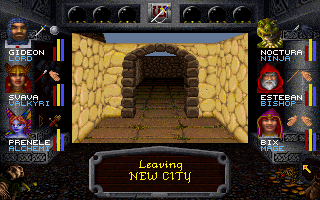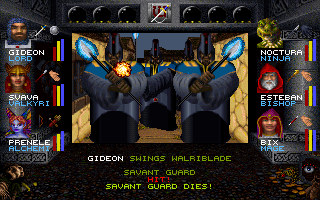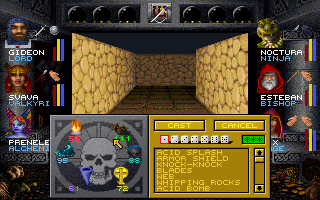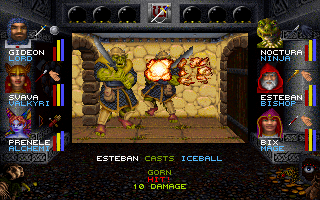From The CRPG Addict
 |
| My party, members now in their permanent classes, confidently marches out of New City. |
When I started this blog, if I referred to “rose-colored memories” of past games, I would have been referring to times I played games in the 1980s or 1990s, when I was young and the games were new. These days, on the other hand, I could use the phrase to refer to games I played at the beginning of this blog. Writing today, I haven’t played any of the pre-Bradley Wizardry games in almost four years. Are my memories accurate? Is my admiration valid?
What I remember most about the original Wizardry, and to a lesser extent the second two scenarios, is a marvelous sense of tension in exploration and combat. Particularly since I was adhering to the series’s use of permadeath, every step forward felt like a risk. The further you got away from the safety of the town level, the more your hit points dropped, the more you depleted your spell slots, the greater the odds were stacked against you. These considerations created a tactical landscape that went far beyond the strict combat mechanics. In deciding whether to try to wipe out your enemies with just a MAHALITO, or to double it up with a MODALTO from another caster, you had to think beyond the immediate combat. You had to worry about the next combat, plus all the combats in your backpath on the way to the surface. Your spell slots were precious resources. You wouldn’t waste a high-level spell on an easy party, just to make combat go more quickly–you needed it for the unanticipated high-level group down the hall.
Wizardry VI completely upended the nature of combat tactics in the franchise while not significantly changing the combat mechanics themselves. You still plan everyone’s action ahead of time, then execute them (in tandem with the enemies’ actions) all at once. You still have limitations on spells, though “slots” have been replaced with magic points, and the spell system in general has been expanded. You still have a lot of variability in the difficulty of enemies that you encounter. The big difference is that you can save, and usually rest, in between combats. The focus is thus entirely on the individual combat rather than the entire landscape. It pays to err on the side of over-use of powerful spells just to make victory certain.
More about combat and magic in a minute, but let’s take a moment to check in with the party, which has undergone some changes since I last blogged. Last time, I was wrestling with the game’s class-changing system, including when and how often. Based on your comments, I realized that I had been thinking of it all wrong. I hadn’t shaken myself out of Dungeons and Dragons (second edition) mode, where dual-classing can create powerful characters, but it pays to get as high as possible in the first class before dual-classing because afterwards you can only level in the second class. Here, that’s not true. Once you acquire skills and spells, they’re part of your repertoire forever, and you can keep adding points to them even if they don’t make sense with your current class. A Dungeons and Dragons fighter who duals to a mage at Level 10 isn’t a fighter at all anymore until she reaches Level 11 as a mage, and even then she’s only kind of a fighter. In this game, even if you only spend one level as a mage, you’re at least partly a mage forever.
(The one big exception here is that your current class defines what weapons, armor, and items you can use. Thus, it doesn’t make sense to build someone’s sword skills to high levels and then dual to a mage, who can’t use a sword.)
 |
| Having been through several class changes, Esteban has a lot of weapon skills at his disposal, only some of which he can actually use as a bishop. |
Thus, I began to think of my party more in terms of what skills I wanted the characters to have rather than literal classes. I spent some time changing, grinding, experimenting, and changing again, in some cases limited by minimum attributes, but generally able to acquire what I wanted. That included at least two characters with high-level mage abilities and at least four characters with healing abilities.
Ultimately, I wanted to end this session with my characters in their “final” incarnations (at least for most of the game). Every time you change a class, you reset the character’s attributes to the minimum requirements for that class. It’s tough to give up all that strength, speed, and so forth, and I imagine it’s particularly tough later in the game, when your foes are harder. As thrilling as it is to level up, I’d rather do it less often but in pursuit of more heroic characters.
One of my first changes was to make my thief a samurai. I can’t really remember why. But once I did, she acquired the “Kirijutsu” skill, and I absolutely fell in love with it. Every point in the skill makes it more likely that the character will strike a critical hit in combat, instantly killing an enemy. I don’t even care if the chance is really small; I just love that the chance s there. Thus, I cycled all my fighters through classes that imparted that skill, at least for a few levels. Three of them were able to change to ninjas for a while, which is a great choice because it has such high attribute requirements that, if you can make it in the first place, you don’t lose as many of your accumulated points.
 |
| Gideon strikes a critical hit on a Savant Guard. This never gets old. |
I advanced in my new classes mostly by grinding in New City. At first, I did this primarily by sleeping in the street, which seems to attract an enemy party about 25% of the time. Later, I realized that if I used the wrong item to try to open a door in one of the buildings (I don’t even know what the right item is), it would reliably send at least one party of Savant Troopers or Savant Guards my way. These guys offer quite a bit of experience, but the problem is that they’re tough enemies. Troopers have lances that can drain stamina and paralyze party members. If I got three parties of 5 Troopers each, I was toast. Nonetheless, it was worth the risk, and I learned a lot about my available spells during the process.
When I was done (and this all took me maybe 8 hours combined):
- Gideon had cycled through several levels as a monk (that was a waste of time) and several levels as a ninja before ending up as a lord again.
- Noctura got some mage spells as a samurai for a few levels before she had high enough attributes to change to her permanent ninja class (she had been a thief originally)
- Bix went from a bard to an alchemist to, finally, a mage. I know that’s not a lot of diversity, but the alchemist position at least afforded him some healing spells.
- Svava went from a Valkyrie to a ninja to a ranger (that turned out to be mostly a waste) and back to a Valkyrie. I had to take her all the way to Level 9 as a ranger because it took forever to reach the Valkyrie minimums.
- Esteban went from a priest to a ninja to finally end up where I wanted him as a bishop.
- Prenele, who was already where I wanted her (alchemist) spent some time as a mage and a priest before returning her her original class.
I might have missed some. I seem to remember having someone as a psionic for a while before realizing the spells just weren’t very good. In any event, I realize that not all of these changes made sense or ultimately served any strategic goal, but remember I was just experimenting, and the best part is that there’s no real harm in trying out a class that doesn’t ultimately work out. The worst that happens is you gained some skills that you don’t bother to develop any further.
 |
| My Valkyrie mulls a class change. Her stats aren’t good enough for lord, bishop, ninja, monk, psionic, or alchemist. |
Just before I started changing classes, some of my higher-level fighters started to achieve extra attacks in combat. They had already been at a point where they often struck twice during a single attack, but eventually they reached a level where they’d get an extra couple attacks at the end of the combat round. The odd thing is that they retained these extra attacks even after they changed classes and were busted back to Level 1 again. So I’m not really sure what governs these extra attacks. I don’t know, it’s probably in the manual somewhere, but the frigging thing is 70 pages long.
The exercise accomplished my primary goal of making a stronger party. Now I have four characters with Kirujutsu, and thus a chance at critical hits every combat round. More important, I have three characters capable of some mass damage spells.
It took me a while to figure out the spell system, and I’m a little fuzzy on parts. Each character has what amounts to a “mana” bar, but that’s a bit misleading because the bar is a composite of each individual status, and each individual maximum, within a variety of spell “realms.” The realms (fire, earth, water, mental, air, and divine) are different from the spell “schools” (mage, alchemist, priest, psionic), each of which has multiple spells in each realm. Right now, my mage Bix has anywhere between a maximum of 22 points (divine realm) and 47 points (water realm) in each realm. His actual spells are a combination of those learned during his time as a bard, an alchemist, and a mage.
When you cast a spell, the number of points available in that realm depletes. Your overall mana bar may look great, but if you’re out of points in the divine realm, there’s no more healing. It takes a long time, or several sleep sessions, to fully restore points in a realm, so my characters basically end up cycling through them. One combat, my mage will favor earth spells, the next he’ll focus on fire spells. It thus pays to have a couple of mass damage spells or a couple of incapacitation spells spread across multiple realms.
What I don’t fully understand is what determines the number of points available to the realms. It’s not based on your skills in the various magic schools, since those apply to all realms. (I think those points just determine what spells are offered to you at each level-up, but I’m not completely sure.) I think it has something to do with the literal number of spells you’ve taken in each realm. Thus, when leveling up, it sometimes pays to choose a spell you don’t really care about, but in a realm in which you want more power.
When casting spells, you have the option to specify a multiplier, from 1 to 7, which is a major consideration. A “Fireball” cast at the base level of 1 only does 2-10 hit points of damage to 3 creatures in a group. Cast at Level 5, it does 10-50 hit points of damage to 8 creatures in a group–but of course it absorbs much more magic. The consideration is there even in status effects like “Cure Disease” and “Cure Paralysis.” Not all disease, poison, paralysis, and other effects are created equal. You have to try to guess how strong it is and then override it with the right spell level.
Even here, there are things I don’t understand. First, you can’t cast a spell at Level 7 the moment you acquire it. But I’m not sure what determines what level you
can cast it at. Your level in the class? Your skill? Your points in the realm? Some combination of these? It’s not even consistent. My Level 4 mage can cast “Chilling Touch” (a water spell) at Level 4 but can only cast “Cure Paralysis” (also a water spell) at Level 2. I know, I know: read the manual. But it’s really long and you guys will tell me what’s happening within 10 minutes of this posting.
 |
| Some of Prenele’s spell options. The dice indicate the spell level, including the nonsensical last die with seven pips on it. |
During my grinding, I really learned to appreciate some of the non-damaging status effect spells. I had already been using “Sleep,” “Hold Monster,” and “Paralyze” quite liberally. The problem with these is that they only take an enemy out of commission for as long as you leave him alone. Once you attack him, the spell wears off. And since you can’t specify particular enemies to attack (just a group), it’s hard to keep everyone incapacitated. These work best when you’re facing multiple groups and you want to sideline two of them so you can focus on one group at a time.
Usually, I go right for the mass damage spells. I have a lot of those now, spread across multiple characters and multiple realms. My favorite is “Acid Bomb,” which damages everyone in a group and keeps damaging them for several subsequent rounds. But for causing more damage in a single round, I have (again, spread over multiple characters) “Magic Missile” (divine), “Whipping Rocks” (earth), “Fire Bomb” (fire), “Fireball” (fire), “Iceball” (water), and “Deadly Air” (air). I don’t yet have any spells that damage all enemies in
all groups, but they’re coming.
 |
| A powerful mass-damage spell. |
To get any serious power out of those spells, however, you have to cast them at high levels and sacrifice a lot of points. My spellcasters can only handle a couple of them before having to rest. What I’ve learned to appreciate are some low-level spells that cost less and greatly reduce the effectiveness of enemies. These include “Confusion,” “Blinding Flash,” and “Itching Skin.” Usually, I don’t like to waste time on spells that don’t show me the effects directly (which is why I never waste a round on “Curse” in D&D games, for instance). But here, those effects are not subtle. When an enemy party goes from a 75% hit rate to a 75% miss rate in one round, you know “Itching Skin” is dong its job.
A lot of single-enemy damage spells were also enormously useful during this process. As I moved from class to class, I didn’t always have the right set of weapons to equip my characters. Thus, spells like “Energy Blast,” “Chilling Touch,” and “Acid Splash,” all of which affect only one enemy at a time, became acceptable alternatives to melee combat. Because they only affect one enemy at a time, they have low casting costs, and you can get half a dozen or so before you need to rest.
So that’s been my last 8 hours. Now I feel better equipped to take on the unexplored areas. I’m still having no luck cleaning up those last few areas of New City, except one previously-locked door that yielded to a “Knock Knock” spell (and had a chest with some decent armor behind it), but by next entry I should have made a lot more progress on the main quest.
Time so far: 31 hours
Original URL: http://crpgaddict.blogspot.com/2018/10/crusaders-of-dark-savant-career-changes.html






